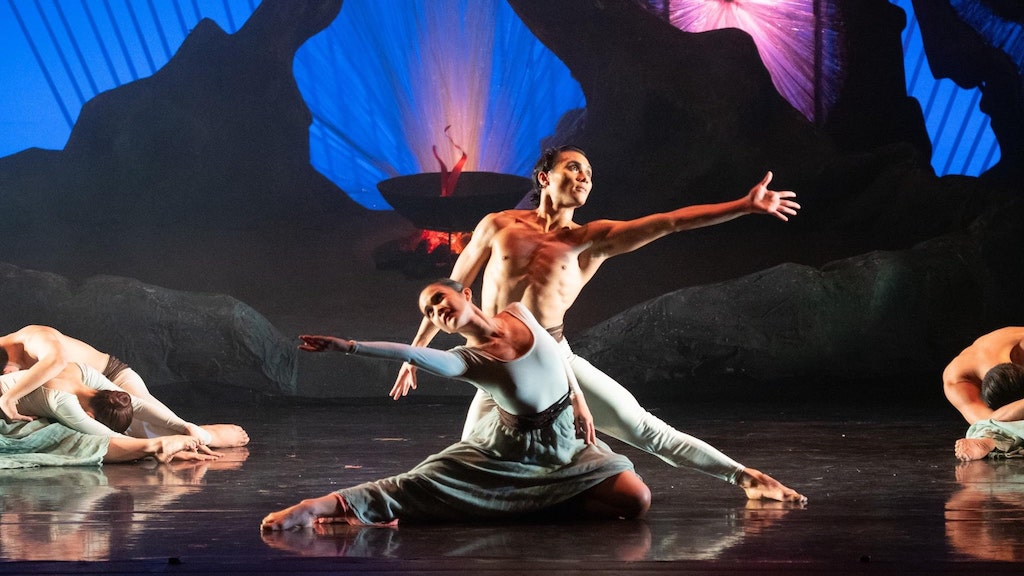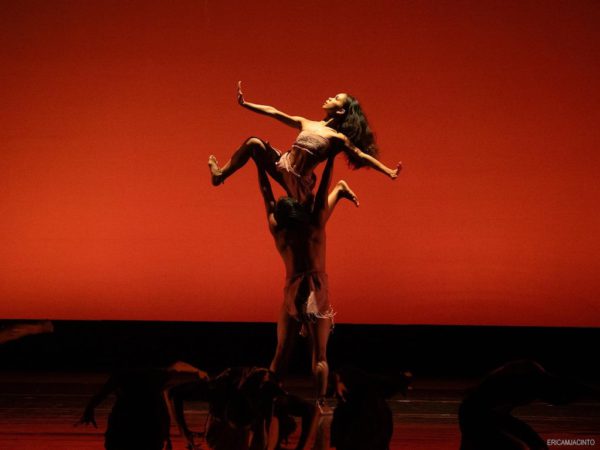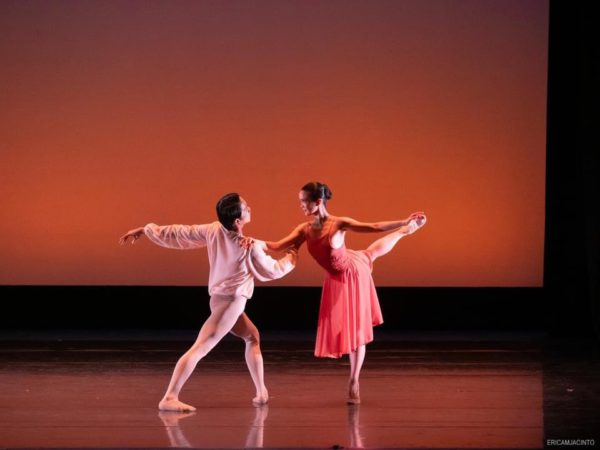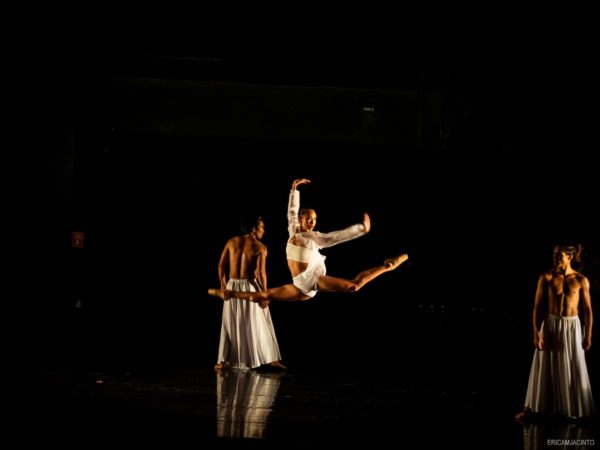
REVIEW: ‘Carmina Burana’ is a true classic whose primal power transcends time
Alice Reyes’ Carmina Burana in 2024 is a richer version than its 2018 run, prefaced with three short yet memorable pieces (Dugso – The Offering, Summer’s End, and After Whom) that bring viewers an intoxicating blend of Western influence Filipinized by local artistry.
Alice Reyes’ ballet company breathed new life to decades-old choreography in a 4-in-1 evening that had audience members standing for ovations and multiple encores. If Carmina Burana is anything to go by, it seems that the National Artist attracts only the best for her company’s productions.
Dugso: A Neo-Ethnic Offering

Crizza Urmeneta as The Girl in Alice Reyes’ Dugso; Photo Credit: Erica Feliz Marquez-Jacinto
The evening began with ten minutes of National Artist Alice Reyes’ choreography in Dugso – The Offering (based on Ding Ding Nga Diwaya composed by National Artist Ramon P. Santos). The curtain rose on dancers in a circle at the start of a sacred rite, a reference to the wheel of fortune in Carmina Burana. They moved at first in silence, accompanied by mere bells to choreography inspired by the actual dance from Bukidnon.
As the music builds in volume and layers, so too does the swirl of bodies while accompanied by Maranao instruments (kulintang and agung) played by Tugtugang Musika Asyatika and the Philippine Madrigal Singers alternately chanting, muttering, then singing in ever growing crescendos.
In this dance, Form is of less importance than the vital energy that the company seemed to have an endless supply of as their bodies writhed and kowtowed. It was regrettable that the live singers and musicians were not seen onstage, and that the sound source seemed to come from loudspeakers, as it gave the audience the impression that it was canned music instead of live, thereby diminishing what could have been Dugso’s greater impact.
Summer’s End: A Romance to Pierce the Heart

Lester Reguindin and Monica Gana in Summer’s End; Photo Credit: Erica Feliz Marquez-Jacinto
Up next was a fifteen-minute pas de deux by pair Monica Gana and Lester Reguindin, dancing with grace on an empty stage beautifully lit by Monino S. Duque. This was love’s eternal longing embodied. They danced barefoot to Norman Walker’s choreography set to the 2nd movement of Chopin’s first piano concerto, a piece that suited the story of lovers’ parting.
The choreography astounded with Gana’s leaps, diving horizontally into Reguindin’s waiting arms, and at one point being carried by him suspended in air, while she extended a leg above her head.
After Whom: The Battle of the Sexes Rendered in Dance

Krislynne Buri in Augustus Bam Damian III’s After Whom; Photo Credit: Erica Feliz Marquez-Jacinto
Film director Jerrold Tarog (of Heneral Luna and Goyo fame) composed the third dance. Hesus ‘Bobot’ Lota’s costumes sent a clear message: men wore skirts, with women in shirts, with the background screen lifted to reveal the naked backstage area.
Choreographer Augustus ‘Bam’ Damian III had his male dancers perambulate in place, skirts billowing with hips sometimes held out to the side, with stationary arms held out like mannequin Sufi mystics. The female dancers had more agency as they strutted about, en pointe. This was social commentary on gender roles in real life.
Carmina Burana’s Timelessness
There is a shocking beauty in perhaps this strangest of classical music pieces. Carmina Burana’s Latin text comes from medieval secular poems preserved in a Bavarian abbey. These ‘Songs from Beuern’ began with a crowd of dancers huddled en masse in the center, surrounded by Salvador Bernal’s set that would not have been out of place on an alien planet, with its sacred votive fire in the middle of two crystalline pillars that twist and turn.
Before we could clap at the spectacle, we were cut off when the Philippine Philharmonic Orchestra (PPO) and the Philippine Madrigal Singers immediately launched into O Fortuna, the infamous, thunderous piece that announces the beginning and end of this hour-long sensual feast. One feels–not just hears–the difference between canned music and the live performers at once: the timpani’s sound waves can be felt on one’s skin especially when soprano Lara Maigue sings In Trutina and Dulcissime.
Carmina Burana is infamously, fiendishly difficult to perform. The evening I watched had the PPO underperforming compared to the other performing groups. Despite conductor Herminigildo Ranero’s clear and efficient handling of the changing meters, there were instances that the orchestra seemed out of sync with the singers, and one time, even amongst the string players themselves. It’s a shame, for otherwise, it would have been a stellar musical evening indeed, as no fault could be found in such primal, powerful dancing, and in the gorgeous singing of the choir.
Having the Kilyawan Boys Choir sing Amor volat undique was so special, as there is nothing on earth as innocent and pure as boy sopranos’ voices alternating with Maigue’s ethereal soprano as they sang, in stark contrast, of the joys of Cupid experienced by couples.
One does not need to understand Latin as Alice Reyes’ choreography for Carmina Burana clearly painted each scene, as we are transported from moaning about the power of Fate and its highs and lows, to Springtime and the joys of youthful love, then to the Tavern, and finally, to the Court of Love.
Watching the dancers move to Orff’s driving rhythms was very primal, bringing to mind Stravinsky as form was superseded by force, primness by power. It speaks of the high standard of the dancers’ collective athleticism and stamina as they performed number after number with tireless precision and clarity.
Carmina Burana is undoubtedly anachronistic. Medieval lyrics, 1930’s music and 1970’s choreography all combine to form something out of time. Listeners feel it when the meter abruptly changes, from measure to measure. Yet its belonging to no one particular time period underscores the message of the evening: Classics are classic because they are timeless.
This production is yet another notch in this young ballet company’s belt, with its succession of artistic victories. From Carmen to Rama Hari, and now, Carmina Burana, ARDP continues to transform Western ballet into a unique legacy that is truly, excellently, Filipino.
Tickets: P1,000 – P3,000
Show Dates: June 14 – 15, 2024 (2:00 PM / 7:30 PM)
Venue: Samsung Performing Arts Theater, Circuit Makati
Running Time: 2 hours (including a 20 minute intermission)
Credits: Alice Reyes (Choreography – Dugso and Carmina Burana), Ramon Santos (Music – Dugso), Ray Albano (Set – Dugso), Salvador Bernal (Costume Design – Dugso and Carmina Burana), Monino S. Duque (Lighting Design – Dugso, Summer’s End, and Carmina Burana), Katz Trangco (Conductor – Dugso), Tugtugang Musika Asyatika (Dugso), Norman Walker (Choreography and Original Costume Design – Summer’s End), Frederic Chopin (Music – Summer’s End), Augustus ‘Bam’ Damian III (Choreography – After Whom), Jerrold Tarog (Music – After Whom), Hesus ‘Bobot’ Lota (Set and Costume Design – After Whom), Aries Alcayaga (Lighting Design – After Whom), Carl Orff (Music – Carmina Burana), Salvador Bernal (Set – Carmina Burana), Herminigildo Ranero (Conductor – Carmina Burana), Ejay Arisola (Ballet Master – Dugso), Lester Reguindin (Regisseur – Carmina Burana), Ronelson Yadao (Artistic Director), Barbara Tan-Tiongo (Technical Director & Lighting Designer), Eric Cruz (Production Consultant), Erlin Arcega (Set Supervisor), Ma. Celina Dofitas (Company Manager and Production Manager), Reymz Rapsing (Stage Manager), and Nonoy Froilan (Coach for Dugso & Summer’s End)
Cast: Ricmar Bayoneta (Babaylan – Dugso), Danilo Dayo (The Boy – Dugso), Richardson Yadao and Sarah Alejandro (The Boy’s Parents – Dugso), Crizza Urmeneta (The Girl – Dugso), John Ababon and Karla Santos (The Girl’s Parents – Dugso), Luigie Barrera (The Rival – Dugso), Monica Gana and Lester Reguindin (Summer’s End), Erl Sorilla, Michaella Carreon, Krislynne Buri, Ejay Arisola, Renzen Arboleda, Dan Dayo, James Galarpe, Francia Alejandro, Gianna Hervas, Cheska Vasallo, Kamille Bautista, the University of the East Silanganan Dance Troupe, the Philippine Philharmonic Orchestra, the Philippine Madrigal Singers, the Kilyawan Boys Choir, Lara Maigue (soprano soloist – Carmina Burana), Byeong In Park (baritone soloist – Carmina Burana)
Company: Alice Reyes Dance Philippines


Comments